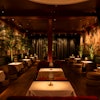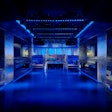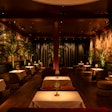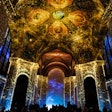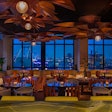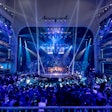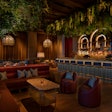
Title: Chairman, CEO & Founder
Age: 40
What She Plans: Magrino's PR and event firm does 40 events a year for clients including big-time publishing and restaurant concerns like Harper's Bazaar, Town & Country and Alain Ducasse. The PR pro has worked on such blockbuster events as the launch of O: The Oprah Magazine and the Winter Antiques Show's opening gala.
When She Founded Her Firm: In 1992, after nine years at Crown Publishing, where she worked with current clients Martha Stewart and Dominick Dunne.
Staff: 20 employees
Favorite Magazine: Copies of Look from the mid-60's
Nights a Week She Goes Out: Four to five nights
How Long She's Been in New York: 19 years
Where She Lives: West 50s
College Major: English, with an art minor, at Skidmore College
In your opinion, what role do you feel events play in PR?
They play an important role. In our case, whether it's an event for Harper's Bazaar or Martha Stewart Living, it's a very important part of branding. But I'm a big advocate of not having a lot of parties—it's having parties for the right reasons that allow you to hone your message. Generally speaking, if a client has more than two, even three, major events a year, you run the risk of people saying, "Oh, they have parties all the time," or "They give a great gift bag—let's go for that."
What gets people to a party?
Number one, you have to choose the date very carefully. You have to make sure, if you have a limited budget, that you're seen and heard. If you're in the food industry, don't do an event during Fashion Week because nobody's coming.
Also, don't make your guests struggle to get a drink and something to eat. That's often a pitfall when people get carried away and there's a lot of production. You really have to make sure your guests can always get what they want. I can't tell you how many times I've been to something where the invitation looks good but then you get in there and you're saying, "Where's the host? Where's the reason we're here?" And if you have a great estate in New Jersey, then you better make it worth their while. Make it a weekend.
You're dealing with an incredibly jaded—and spoiled—public that's been wined and dined very well for 25 years. Music is also important. If the momentum of the party has to stop because everyone has to watch a concert or listen to a song because the artist is breaking a new album, that's bad news. I've been to events where, the minute the live performance started, everyone left.
How are your clients' budgets changing?
For a while, even if they had the budget, they didn't want to be perceived as spending it. In some cases, they may do more in-house. A lot of companies are starting to train more in-house or rely on existing resources and people on payroll to do things.
How has the economy scaled back your clients' events?
Bars are definitely pared down. I haven't been to an event where there was a full bar in a while. Instead people will choose a fabulous drink, like a mojito. I'm not seeing as much champagne. The really over-the-top invitation—we're not going to see that for a while. However, it's still possible to create something eye-catching. I think you have to look at every event in every situation and figure out who's the target audience and what's the best way of reaching them given the budget. Gift bags seem to be going strong—that's how you really build brand loyalty. I'm an absolute loyalist on certain cosmetics that I never would have bought otherwise, because I've gotten them in gift bags.
What's the biggest challenge facing the industry?
Everyone is always looking for a new space, and that continues to be a challenge for all of us—finding spaces people have never been to or are curious about, and not terribly difficult to get to. But New York has a lot of existing spaces that don't market themselves—the New-York Historical Society has been used for fashion shows because of its narrow rooms.
What has been your best venue discovery?
Cooper-Hewitt National Design Museum. We did Coach's Cocktails in the Garden party there.
Can you name a few vendors you recently tried who impressed you?
One Dream Sound. We used them for the Baker Furniture store opening and the Coach garden party. Also Match Catering—they understand the mood of a room.
What's your vendor pet peeve?
Getting there late—particularly if it's a florist or a photographer. Because often the most important people are arriving at the beginning and if the photographer isn't there, why have a party? That's the biggest crime—not having pictures from an event.
Who do you admire in the event industry?
Caterers, as a group. They have one of the toughest jobs and they're forced to work under conditions where ice melts or there's no gas in the oven. Everyone has to be in a good mood, and everyone has to look good. Florists can arrange the flowers and leave, but the caterers have to get through the day and make everyone happy. They're pretty important people.
What have you learned about PR from handling Martha Stewart's PR this year?
We've done everything we've always done. If a journalist calls, you have to get back to them—even if you can't elaborate and give them more information. You still have to work together and you still need each other. You really don't want to get blindsided—you want them to call and ask the questions. You don't want to pick up the paper and find "So-and-so didn't have a comment."
This story originally appeared in the Winter 2003 issue of the BiZBash Event Style Reporter newspaper.
Age: 40
What She Plans: Magrino's PR and event firm does 40 events a year for clients including big-time publishing and restaurant concerns like Harper's Bazaar, Town & Country and Alain Ducasse. The PR pro has worked on such blockbuster events as the launch of O: The Oprah Magazine and the Winter Antiques Show's opening gala.
When She Founded Her Firm: In 1992, after nine years at Crown Publishing, where she worked with current clients Martha Stewart and Dominick Dunne.
Staff: 20 employees
Favorite Magazine: Copies of Look from the mid-60's
Nights a Week She Goes Out: Four to five nights
How Long She's Been in New York: 19 years
Where She Lives: West 50s
College Major: English, with an art minor, at Skidmore College
In your opinion, what role do you feel events play in PR?
They play an important role. In our case, whether it's an event for Harper's Bazaar or Martha Stewart Living, it's a very important part of branding. But I'm a big advocate of not having a lot of parties—it's having parties for the right reasons that allow you to hone your message. Generally speaking, if a client has more than two, even three, major events a year, you run the risk of people saying, "Oh, they have parties all the time," or "They give a great gift bag—let's go for that."
What gets people to a party?
Number one, you have to choose the date very carefully. You have to make sure, if you have a limited budget, that you're seen and heard. If you're in the food industry, don't do an event during Fashion Week because nobody's coming.
Also, don't make your guests struggle to get a drink and something to eat. That's often a pitfall when people get carried away and there's a lot of production. You really have to make sure your guests can always get what they want. I can't tell you how many times I've been to something where the invitation looks good but then you get in there and you're saying, "Where's the host? Where's the reason we're here?" And if you have a great estate in New Jersey, then you better make it worth their while. Make it a weekend.
You're dealing with an incredibly jaded—and spoiled—public that's been wined and dined very well for 25 years. Music is also important. If the momentum of the party has to stop because everyone has to watch a concert or listen to a song because the artist is breaking a new album, that's bad news. I've been to events where, the minute the live performance started, everyone left.
How are your clients' budgets changing?
For a while, even if they had the budget, they didn't want to be perceived as spending it. In some cases, they may do more in-house. A lot of companies are starting to train more in-house or rely on existing resources and people on payroll to do things.
How has the economy scaled back your clients' events?
Bars are definitely pared down. I haven't been to an event where there was a full bar in a while. Instead people will choose a fabulous drink, like a mojito. I'm not seeing as much champagne. The really over-the-top invitation—we're not going to see that for a while. However, it's still possible to create something eye-catching. I think you have to look at every event in every situation and figure out who's the target audience and what's the best way of reaching them given the budget. Gift bags seem to be going strong—that's how you really build brand loyalty. I'm an absolute loyalist on certain cosmetics that I never would have bought otherwise, because I've gotten them in gift bags.
What's the biggest challenge facing the industry?
Everyone is always looking for a new space, and that continues to be a challenge for all of us—finding spaces people have never been to or are curious about, and not terribly difficult to get to. But New York has a lot of existing spaces that don't market themselves—the New-York Historical Society has been used for fashion shows because of its narrow rooms.
What has been your best venue discovery?
Cooper-Hewitt National Design Museum. We did Coach's Cocktails in the Garden party there.
Can you name a few vendors you recently tried who impressed you?
One Dream Sound. We used them for the Baker Furniture store opening and the Coach garden party. Also Match Catering—they understand the mood of a room.
What's your vendor pet peeve?
Getting there late—particularly if it's a florist or a photographer. Because often the most important people are arriving at the beginning and if the photographer isn't there, why have a party? That's the biggest crime—not having pictures from an event.
Who do you admire in the event industry?
Caterers, as a group. They have one of the toughest jobs and they're forced to work under conditions where ice melts or there's no gas in the oven. Everyone has to be in a good mood, and everyone has to look good. Florists can arrange the flowers and leave, but the caterers have to get through the day and make everyone happy. They're pretty important people.
What have you learned about PR from handling Martha Stewart's PR this year?
We've done everything we've always done. If a journalist calls, you have to get back to them—even if you can't elaborate and give them more information. You still have to work together and you still need each other. You really don't want to get blindsided—you want them to call and ask the questions. You don't want to pick up the paper and find "So-and-so didn't have a comment."
This story originally appeared in the Winter 2003 issue of the BiZBash Event Style Reporter newspaper.



